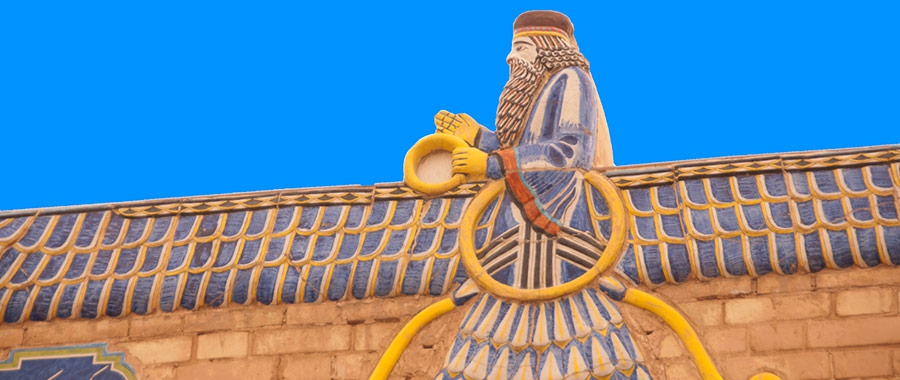The views expressed in our content reflect individual perspectives and do not represent the authoritative views of the Baha'i Faith.
Baha’is claim that Baha’u’llah was the “Promised One” of all religions. Does this truth-claim withstand scrutiny?
Can the Baha’i principle of the “harmony of science and religion” somehow be applied to such an inquiry? How can investigating the truth of Baha’u’llah’s prophetic claims proceed in a fairly straightforward, fairly objective way, when believing such a claim is ultimately a matter of faith? If Baha’u’llah’s claim to be the world-messiah, i.e. the “Promised One” of all religions for this day and age, can be rationally evaluated, wouldn’t it make sense to look at each religious tradition at a time?
Take, for example, the ancient Zoroastrian religion. Its founder and prophet was Zoroaster—the Greek name for the original Persian name, Zarathushtra—who lived around 1,000 years before Christ. The prophecies attributed to Zoroaster are rather general in nature, and basically developed into prophecies of three successive messiahs, or saviors, who would appear at 1,000-year intervals after Zoroaster himself. Over the ensuing time-span of 3,000 years, the third of these three messiahs should have appeared by the year 2000. If Zoroaster’s date was, say, 1100 B.C.E., then the third and final Zoroastrian savior should have appeared in the 19th-century.
Cambridge Orientalist Edward Granville Browne, who traveled in Persia in the years 1887–1888, documented that the expectation, by Zoroastrians in Persia, of the imminent advent of a Zoroastrian messiah was alive and well.
But the expectation was not so much for the third of the three Zoroastrian savior figures, but for the appearance of a military leader named “Shah Bahram.” For all the popular hype about Shah Bahram’s appearance, rarely would any actual prophecy regarding Shah Bahram ever be quoted or cited. So, for the purpose of this investigation into this particular application of Baha’u’llah’s messianic truth-claims, let’s look at the Shah Bahram prophecy itself. Here is one translation, published by a scholar in the Journal of the Royal Asiatic Society:
1. When may it be that a courier [messenger] comes from India,
(And says) that: “The Shah Vahrām from the family [lineage] of the Kay-s [Kayanids] has come [arrived],
2 . That there are a thousand elephants, upon their heads are elephant keepers [elephant-drivers],
That he holds the raised [adorned] standard in the manner of the Husravs [renowned kings],
3. …
That the advance-guard is led by the army-chiefs!” —
4. An intelligent man should be made (our) clever interpreter,
Who may go and speak to the Indians:
5. Namely, “What have we seen from the hand of the Arabs!
For the unique people they ruined the Religion and killed the kings.
6. We are from the Aryan (stock) [Iranians], they are like the Dēv-s [demons];
And they hold the [their] religion [in the manner of the demons], eat bread like dogs.
7. They have taken away the sovereignty from the Husravs [renowned kings],
Not by skill, nor by manliness,
8. [But through] mockery and scorn,
…
9. They have taken away by force from men
(Their) wives and wealth, sweet places, parks and gardens.
10. Capitation-tax [poll-tax] they have imposed, they have bestowed it upon (their own) chieftains;
They have [sought the cloth and] demanded a heavy tribute.
11. Consider [Behold] how much evil that Druz [demon] has cast upon this world,
So that nothing is worse than that [there is no more evil than they in the] world !” —
12. “From us shall come [will arrive] that [king] Shah Vahrām,
The Glorious, from the family of the Kay-s [Kayanids].
13. [Then] We will bring vengeance on the Arabs,
As Rōtastahm [Rostam] brought vengeance [a hundred revenges of Siyāwash].
14. Their mosques we will cast down, we will set up establish] fires,
(Their) idol-temples we will dig down and blot them out from the world,
15. So that ‘nihil’ [Latin: naught, nothing, nil] shall be the miscreations of the Druz [daevic creatures]
From this world.”
– Translated J. C. Tavadia, “A Rhymed Ballad in Pahlavi,” Journal of the Royal Asiatic Society of Great Britain and Ireland (April 1955): pp. 29–36 [pp. 31–32], with additional translations provided by the present writer [in brackets], based on a recent translation by Touraj Daryaee, “On the Coming of a Zoroastrian Messiah: A Middle Persian Poem on History and Apocalypticism in Early Medieval Islamic Iran,” in Converging Zones: Persian Literary Tradition and the Writing of History: Studies in Honor of Amin Banani (Costa Mesa, CA: Mazda Publishers, 2011), pp. 5–14 [pp. 10-11].
Without delving into the technical discussion of some of the unfamiliar vocabulary, suffice it to say that this prophecy, which, on its face, appears to “foretell” the future events it describes, clearly portrays the conquest of Persia (now Iran) by “the hand of the Arabs.” This refers to the conquest of Persia by Muslims in the seventh century CE (c. 651 CE).
Note that “For the unique people they ruined the Religion and killed the kings” clearly refers to the Persians themselves (“the unique people”), to Zoroastrianism (“the Religion”), and to the Sasanian dynasty (”the kings”), who were overthrown by the Arab/Muslim invaders. The Muslim rulers imposed a “Capitation-tax” described as a “heavy tribute” that the subjugated Persian Zoroastrian population had to pay under Muslim rule. You can read about these historical events, in detail, elsewhere.
The fact that Shah Bahram comes from India with an army of “a thousand elephants” makes perfect sense in that, after the Arab conquest of Persia, many Zoroastrians migrated to India, where they live to this day, and are known as “Parsees.”
Here’s where the Baha’i principle of the harmony of science and religion comes into play. In the academic study of religion, “science” would basically correlate to what academics call “scholarship.”
Scholars say that this Shah Bahram prophecy was written after the Arab conquest of Persia, not before. So, for that part at least, this text is not really a true prophecy.
As for advent of Shah Bahram, this prophecy appears to be modeled on three, intertwined sources: (1) the Persian god of victory, Vərəθraγna/Warahrān/Bahrām; (2) the celebrated exploits of a warrior/ruler named Bahrām Chūbīn, Sasanian king (reigned 590–591 CE), whose legendary military feats are projected into the future; and (3) a son of the last Sasanian king, Yazdegerd III (reigned 632–651 CE), Wahrām (d. 710 CE, known as “Aluohan” in Chinese sources), who unsuccessfully tried to recapture lost territories from the Arab Muslims.
This makes sense, especially if this “prophecy” is analyzed as a “wish-image,” i.e. the yearnings of an oppressed people (the Persian Zoroastrians) for liberation.
This liberation, of course, would take the form of another war: “We will bring vengeance on the Arabs.” So the “prophecy” of Shah Bahram is not about world peace. It’s about “vengeance” against Muslims (“the Arabs”). Scholars generally believe that apocalyptic texts—prophecies of future events—are a form of “crisis literature.”
Note that Shah Bahram, as described here, will lead a rebellion, an uprising of Persians against “Arabs.” Their places of worship will be destroyed (“Their mosques we will cast down”) and there will be the restoration of Zoroastrian sacred altars as well (“we will set up fires”).
Presumably, the prophecy implies that after the Muslims in Persia are defeated, the ancient Zoroastrian religion will be restored to its former glory.
So the question arises, in light of this prophecy: Is Baha’u’llah the promised “Shah Bahram,” as Baha’is claim Baha’u’llah to be?
Literally, the answer would have to be, “No,” since Baha’u’llah was not a military leader, was instead a prisoner, was not a conqueror, did not overthrow the Muslims in Persia, did not destroy mosques, and did not restore Zoroastrianism as the state religion of Persia.
If Baha’u’llah did none of that, then how could he be Shah Bahram? Good question! Here are a few thoughts to consider:
This prophecy (understanding that scholars have cast doubts as to whether this is a genuine prophecy at all) is clearly religiocentric (focused on the fortunes of Zoroastrianism) and ethnocentric (concerning Persians), not universal. So what Baha’u’llah, by implication, has done is to universalize this prophecy. He does so by radically redefining and reinterpreting this wished-for prediction of the coming of Shah Bahram. In a sense, Baha’u’llah, in order to fulfill this prophecy, has negated its original intent in favor of much more progressive vision of the future. Baha’u’llah proclaims:
The fourth question: “Our Books have announced that Sháh Bahrám will come, invested with manifold signs, to guide the people aright ….”
O friend! Whatsoever hath been announced in the Books hath been revealed and made clear. From every direction the signs have been manifested. … Beseech the peerless and incomparable Lord to bestow a penetrating insight upon His servants, for insight leadeth to true knowledge and is conducive to salvation. … Were the children of men to gaze with the eye of understanding, they would see the world illumined with a new light in this day. Say: The Daystar of knowledge is manifest and the Luminary of insight hath appeared. – Baha’u’llah, The Tabernacle of Unity, pp. 60–61.
















Comments
Sign in or create an account
Continue with Googleor